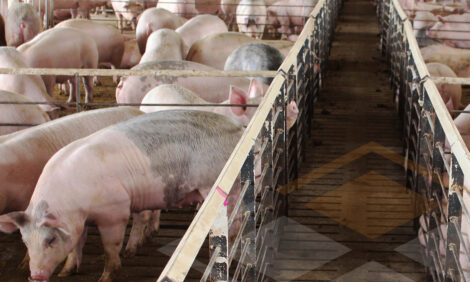



Post-Weaning Wasting/Catabolic Syndrome: An Emerging Disease?
A review of what is known - and not yet known - about Post-Weaning Wasting/Catabolic Syndrome (PWCS) by Jackie Linden, editor of ThePigSite.A month ago, ThePigSite included a short article on a little-known disease syndrome of piglets: Post-Weaning Wasting and Catabolic Syndrome (PWCS). It seemed to be a new or emerging disease, so what does a literature search tell us about the syndrome?
As reported on ThePigSite last month, Dr Yanyun Huang from the Western College of Veterinary Medicine in Saskatoon, Canada, explained that the cause and control of PWCS remain elusive. Dr Huang had addressed the Manitoba Swine Seminar 2010 in Winnipeg on this subject.
He said that the disease has been identified on a farm in Saskatchewan and that there have been similar cases reported in Kansas but that so far, scientists have have not yet found the cause of the disease.
Usually the disease occurs shortly after weaning, he explained, with pigs showing the first signs within during the week after weaning, and these become obvious in the following week. Pigs become very thin, lose condition and usually die (or have to be euthanised) by the third week.
Morbidity and mortality may rise and fall over time but at its peak, between five and ten per cent of the animals are affected and die. There is sometimes a reduction in the incidence following thorough disinfection of the farrowing room and nursery but Dr Huang said this may be related to the fluctuating pattern of PWCS.
This latest paper seemed to leave many questions about the Syndrome unanswered.
First Reports of PWCS
A look back in the published literature revealed the first mention of PWCS to be in September 2008. In an article in National Hog Farmer, Joe Vansickle wrote that researchers across the US were trying to find out why healthy-looking nursery pigs appeared to be starving to death.
He explained that Kansas producers started reporting problems about 10 months previously – at the end of 2007. Dr Mike Tokach, Extension swine specialist with Kansas State University (KSU) described the symptoms and said that, in affected barns, between two and 10 per cent of pigs either died or wasted away.
A trial at KSU sought to find a dietary link but there was no evidence that diet is playing a role.
Dr Tokach hypothesised that PWCS is a multifactorial disease, with management, feed ingredient quality and possibly timing of vaccinations all being involved.
The article went on to cover a paper at the 2008 Al Leman Swine Conference by a Kansas veterinary team comprising Luc Dufresne, DVM (Seaboard Foods), Thomas Fangman, DVM (Boehringer Ingelheim Vetmedica, Inc.) and Steve Henry, DVM (Abilene Animal Hospital, Kansas).
They reported the same symptoms in affected pigs and added that even with early detection and immediate supportive nutrient and antimicrobial intervention, affected pigs catabolised fat and muscle tissue over two to three weeks.
The veterinarian confirmed the symptoms and said that postmortem examination revealed a breakdown of fat in organs and a depletion of fat reserves in most parts of the body. The gastrointestinal tract contained no feed, faeces are pasty and scant and most pigs appeared not to have eaten since weaning.
Dr Henry stressed that the pigs had been in good condition at weaning – weighing 13 to 16lbs at 21 to 24 days of age – and they were vigorous and active. Dr Dufresne says the Seaboard production system was weaning pigs at 16 to 18 days of age but their experience was similar.
He added: "What has changed, lately, is the increase in prevalence of the condition. The combined results of six, system-wide necropsy audits, performed between March 2003 and May 2006, and involving several thousand pigs, show that failure to thrive was the fourth most important cause of mortality behind pneumonia, polyserositis and colitis."
Two different patterns of the syndrome emerged, Dr Dufresne said: one was a high incidence of failure to thrive with a high rate of colitis and pneumonia. Diagnostics implicated salmonella and rotavirus, and they suspected that the failure to thrive was initiated by one or both of these pathogens.
He explained that the use of vaccination, strategic antibiotic treatment and partial depopulation has greatly reduced mortality on those farms and that the syndrome was continuing but at a much lower level.
However, a different trend had emerged over the previous year on some of Seaboard's farms, he said, where the failure to thrive was one of the two major causes of mortality, without colitis or enteritis.
Dr Dufresne added three other observations:
- The severity of the syndrome is sow-farm dependent. When pig sources are combined in the same nursery barn, the prevalence of failure-to-thrive pigs can be four to five times higher among pigs form one source than another.
- Porcine reproductive and respiratory syndrome (PRRS) can be involved, but not always.
- Males are more affected than females.
Dr Henry raised a number of dietary considerations, including the gradual reduction in the quality and quantity of milk protein and fish meal in starter diets in order to reduce diet costs.
He summed this up saying: "The greatest frustration is that we have learned much about ingredients to increase consumption, help the immune system, reduce villus atrophy, alter pH, etc. and yet, getting pigs started on feed is a bigger issue today than in years past."
On other possible causes of PWCS, the team agreed that infections with PRRS, swine influenza virus, circovirus, salmonella and rotavirus can certainly compromise the pig, and combined with a lack of feed consumption, they lead to a failure to thrive and ultimately death.
The environmental stress of chilling, plus the competition associated with establishing dominance during post-weaning, places these challenged nursery pigs more at risk, they said.
Specific efforts to improve pig performance have included hand-feeding pellets, the use of milk products and milk replacer, dextrose/electrolyte preparations and multi-day supplementation with concentrated glucose/glycine solutions. Diets have also been supplemented with nutrient-dense feeds and complex protein and lactose but none of these consistently prevents or reduces the Syndrome.
No Link to PMWS – But to Brain Development?
The only other scientific report on PWCS is in AgCanada. R. Friesen states that a handful of cases have been detected so far in Saskatchewan, plus a few suspected cases in Manitoba and Alberta.
Dr John Harding, an associate professor with the Western College of Veterinary Medicine at the University of Saskatchewan – who has worked on PWCS with Dr Huang – explained that at first glance, PWCS appears to be like Postweaning Multisystemic Wasting Syndrome (PMWS), a pig disease caused by porcine circovirus Type 2 (PCV2).
But although it exhibits similar clinical signs, such as wasting, PWCS is not PMWS, Dr Harding asserted, for three reasons.
Firstly, he explained, PMWS occurs at the late nursery stage or, more commonly, the grower-finisher stage, while PWCS usually affects pigs one to three weeks after weaning.
Second, PMWS causes extensive and easily visible damage to internal organs. The organs of PWCS pigs show three characteristic lesions, of which only one – severe atrophy of the thymus gland – is readily obvious. The other two are detectable only by microscope.
And third, there is no evidence in PWCS-affected pigs of circovirus, the agent in PMWS.
Dr Harding said researchers are now trying to reproduce the disease – if indeed that is what it is – but he is not convinced PWCS is infective. He speculates that the Syndrome could be a behavioural disorder caused by an immaturity of the brain.
Summary
PWCS remains a mysterious condition. It was first seen in Kansas and has occurred – though not widely – in the Canadian provinces of Saskatchewan, Alberta and Manitoba. It causes mortality of between two and 10 per cent in piglets in the first three weeks after weaning, apparently from starvation. The cause – whether a single pathogen or multifactorial – is presently unknown and there is no reliable control method.
References
Friesen R. 2010. Research continues into PWCS: new pig disease poses a puzzle. AgCanada. 11 February 2010.
Huang Y. 2010. PWCS: cause and control remain elusive. Farmscape. 16 February 2010.
Vansickle J. 2008. Researchers scramble to solve failure to thrive syndrome. National Hog Farmer. 15 September 2008.






